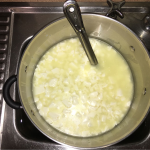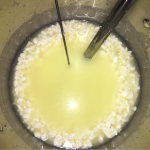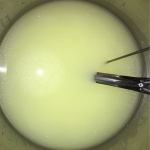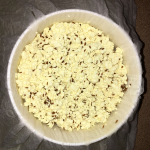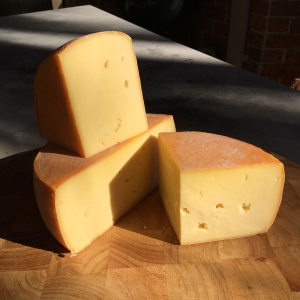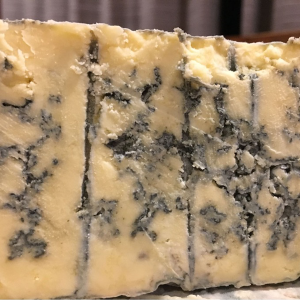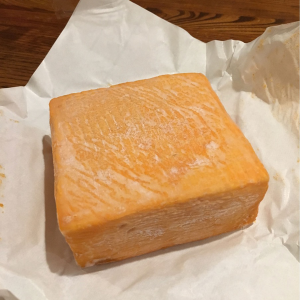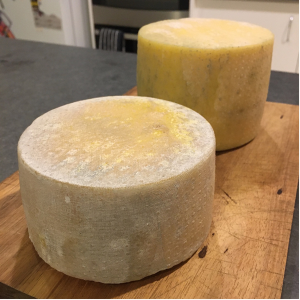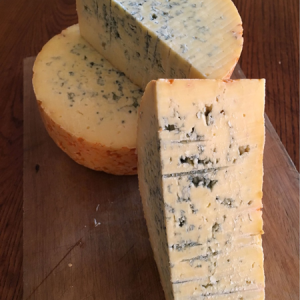When did you take up cheesemaking and why?
I’ve always been interested in self-sufficiency and working with limited ingredients to achieve vastly different results. (Beer, bread making being the two obvious examples of 3-4 ingredients).
Or what sparked your interest in making cheese
I once saw a video of quick mozzarella cheese making and I was amazed at the transformation of milk into cheese in such a quick time.
What was the first batch of cheese you made by yourself? How did you feel about the experience and how did the cheese turn out? Can you compare your experience between then and now?
I had made yoghurt for years and felt ready to make cheese. I got a Mad Millie quick cheese kit and had purchased Ricki Carrols ‘Home cheesemaking’ book so I was all set to go. I was pretty much hooked but didn’t really progress until I did a basic cheese class in 2013. Since then, I have built up my cheese knowledge in a bit of a stop and start way.
What sort of cheeses (& dairy products eg yoghurt) do you make, how many times have you made cheese, why do you like making cheese and how often do you make it?
I have made most types of cheeses with mixed success. By some strange chance, I have always made good blues – I seem to understand these cheeses (if even by accident). I’ve had plenty of failed cheeses too. I would say with washed rind cheeses that you can expect to fail several times before you make a good one. I think I had 4 failures before I made a good one. Cheddar type of cheeses are all about getting the acid right and I learnt the hard way why this is the case. White moulded cheeses remain a challenge to age correctly. These guys can run away from you and get quite strong and runny. Alpine cheeses (Gruyere, Comté, Emmental, Raclette etc) have defeated me many times – but I have made a few good ones too.
I make cheese every 2-3 weeks during winter. In summer I just make feta, halloumi, white moulded cheeses and Dutch cheeses. I make yoghurt every 2 weeks.
What have been some interesting or rewarding cheesemaking experience/s
Any cheese that looks attractive and tastes great is always a moment of joy for me. I have ticked most of the boxes on cheese varieties and am now at the stage of expanding my knowledge and getting more consistent results. I like to explore the multiple ways of making camemberts/bries (cultures: including stabilising thermo ones, washing the curds, higher temps etc). I am currently exploring feta using a variety of cultures, including yoghurt. Infused oils (and their safe use), whey brines vs normal brines. Lactic set fetas. My youngest son is nuts on feta.
What has been your biggest cheesemaking challenge/s
Probably washed rinds and how to look after them. In fact, setting up the right conditions for any mould is a challenge.
What is your favourite cheese(s) to make?
Leiden. Basically a gouda with cumin seeds. I have a Dutch heritage and this cheese takes me back to my childhood. It’s a great sandwich cheese.
What cheese do you regularly have in your fridge OR What cheese cannot you do without
Parmesan, aged cheddars and feta. All are constantly used in cooking and snacks.
What is your advice to anyone looking to start out on a cheesemaking journey?
Do a course! And grow from there.
Do you have a favourite cheesemaking recipe that you can share with others? (others do like to copy their recipes). An image of that cheese is helpful
Gouda, Leiden and Havarti all from one batch!
This is a great cheese to make if you have made just a few cheeses. It’s uncomplicated and provided you follow a few basic rules you will have a great tasting cheese in just 3 months!
I like to make this cheese in a 12-litre batch so that I can split the curds to make a Leiden/Gouda with roughly 8 litres of curd (800g thereabouts) and Havarti with the remaining 4 litres of milk. It’s pretty cool getting multiple cheeses out of one batch of curds! These are washed curd cheeses so you will need to have some boiled water prepared beforehand. Hygiene is critical in these cheeses (it is in all cheeses).
Traditionally Gouda/Leiden cheeses are made with skimmed milk and aged longer, but I make these with jersey milk, which is higher in fat than most other cows’ milk and has more protein, so it produces a lovely creamy cheese that is ready to eat in 3-4 months. Traditionally Gouda is washed twice, but some do 1 wash and some do 3 washes, I prefer 2 washes. The curd is ‘cooked’ by replacing some of the whey with hot water. 38C degrees is the target temperature. You can try to do your own variations here and use lower temperatures and less stirring for softer cheeses or higher temps and more stirring for a drier cheese. Note that your mesophilic cultures will not work well if you pass 40C, so avoid that!
Another great thing about this cheese is its ability to be infused with different spices. Here I use cumin seeds, but you can use almost anything (dried chilli, mustard seeds, caraway seeds, peppercorns and even walnuts)
It’s worth taking a step back here and seeing how Gouda fits into the washed curd family. Gouda uses hot water washes, Saint Pauline (Port Salut) uses the same temperature washes and traditional Colby and Monterey Jack use cold water washes. Coldwater makes curds swell up and this results in a very mild cheese that has a short shelf life. Some washed curd cheeses have natural brevi wash rinds, like Port Salut, but Gouda doesn’t and is normally vacuum-sealed or waxed, once dried.
Finally, a word on culture, Gouda is pretty flexible and can be made with ANY mesophilic starter culture. I like MM100, M272 and sometimes Flora Danica. If you want to put a twist into your Gouda then add some lactobacillus helveticus as well and you will get a sweeter cheese.
Recipe for Gouda with cumin seeds ‘Leiden’ (and Havarti with dill)
- Sanitise all equipment and work surfaces
- Heat 12 Litres of milk to 30C in a water bath (if using a stovetop stir constantly) add 2.8ml calcium chloride and starter cultures. Sprinkle 1 heaped 1/8 spoon (dash spoon) of your selected mesophilic culture, over the milk. (Check the dosage rate as some cultures are more concentrated than others) Stir through milk.
- Ripen the milk for 30 minutes and maintain the temperature.
- Stir in 2.8ml vegetarian rennet and set for 30 minutes. In the meantime, heat your previously boiled water to 55C. Sanitise your 2 cheese cloths and 2 moulds (1 suitable for a 1kg cheese and a smaller ½ kg mould, both with a base and follower. In 2 separate pots boil 2-3 teaspoons of cumin seeds in one pot AND 1-2 teaspoons of dried dill (don’t use fresh dill!) in the other pot, in a cup of water, for 5 minutes. Don’t let it boil dry! You want to keep some of that liquid behind. Let both pots cool.
- Cut the curd to 1cm cubes and wait 5 minutes for curds to ‘heal’.
- Then slowly stir the curds for 10 minutes and then allow the curds to settle for 5 minutes.
- Take note of the level of the curds. Then take a sanitised cup and remove the whey down to the level of the curds. You may need to use a sanitised wide cheese mould to aid your removal of the whey. Replace that whey with 55C hot water to slowly bring the temp up to 33C. Make sure you stir constantly as you don’t want to overcook any of the curds. (between stirs, heat the rest of the pot water up to 65C.) Stir for 10 minutes, let curds settle for 10 minutes, then repeat the process but with hot water at 65C temperature. The goal temperature is 38C, if the curds aren’t at that DON’T add more hot water, rather increase the water bath temperature to bring them up to temperature. Stir constantly.
- Once at 38C stir for a further 20 minutes, then allow curds to settle for 10 minutes. The curds will clump together and make it easier to drain the whey off.
- Now remove 1/3 of the curds and place that in a sterilised tub or pot. Keep 2/3 of the curds warm by putting the lid back on the pot/vat to keep them warm.
- Now for Havarti, add the boiled dill leaves to the curds and mix them together, and break up the curd mas by hand. Line the smaller mould with a cheesecloth and place curds into the mould. Close the cheesecloth over and add in the follower. I like to have a drainage tray below this mould and if the room is cool put it into a closed sanitised container to keep it warm. Put a small sanitised can (I put it in a zip lock bag that has been sanitised) that weighs 200g thereabouts on top of the follower. We want a loose and open texture for this cheese. After 1 hour flip and redress the cheese and put a bigger can (400g) on top of the follower (be sure to sanitise the can and position it in a way that won’t tilt on the follower). Press overnight (8-12hrs)
- Now for the Leiden. Add the cumin seeds and the cumin water to the other curds. Mix in well. (Some people like to keep some seed free curds to top and tail the cheese – I don’t bother with that). NOTE: If you don’t add the seeds you will just have a Gouda cheese. Now place curds into a cloth-lined 1kg mould and place in your cheese press.
- Press cheese at light pressure for 30 minutes. If you press too hard too early you will trap whey in the curds and you will have a cheesecloth that has embedded itself into the rind – it will tear the cheese apart when you try to remove it. Remember the aim is to close the rind and gradually remove the excess whey. This is a moist cheese so it isn’t pressed as hard as a cheddar.
- Remove cheesecloth and flip cheese. Place redressed cheese back into the press and press at medium pressure 10-15kg overnight.
- Prepare a 20% Brine (4 litres water, 800 grams of preserving salt – no iodised salt, add 1 teaspoon of white vinegar and 1 tablespoon of 30% calcium chloride {that’s the normal home cheesemakers calcium chloride}). Cool brine down overnight to 10C.
- The following morning brine each cheese for 3hrs Havarti (400gms thereabouts) and 6-7hrs Leiden/Gouda. Be sure they are submerged in brine otherwise, you may need to salt the exposed top of the cheese and flip it halfway through its brining and resalt the underside. Brining is based on 1kg = 6-8hrs.
- Once brined, place in cheese cave uncovered and dry off the surface. (1-2 days). Then vacuum seal the cheese and age for 3-4 months. Don’t overage these cheeses (unless you made them with skimmed milk), they start to deteriorate after a year. I think 7 months is really the limit for the full-fat cheese. Age at 10-12C. Flip the cheese once a week. Cheese can go into a normal fridge after 3 months but will be mild in taste.
- This cheese is normally just a sandwich cheese but can be melted over veggies like carrots, cauliflower and broccoli.
Notes: You will need to tinker with the water temperatures washes, the more you make this cheese, as different kinds of milk produce more/fewer curds. But remember to not heat curds too quickly and shock them with hot water AND increase the water bath temperature to get you to 38C. Enjoy these cheeses, and if you have any Dutch or Danish friends surprise them with these cheeses.
Do you have a favourite cheese(s) and cheese pairing(s)
Blues – In soup, on steak, on pizza with mushrooms and ham, with grapes and pears and sweet white wines.
Feta – On chips (the Greek way), salads, in gozelemes, tomatoes, stuffed in bell chillis
Washed rinds – Tartiflette, on sourdough bread, cheese boards
Camembert/Brie – On crackers, in chicken burgers with bacon and cranberry sauce, baked with wine and garlic/herbs
What cheese do you want to make but have not made?
Sbrinz, Montasio, Fontina, Caciocavallo… A better Gruyere (I have yet to make a really good one), gorgonzola dolce (using a feta recipe), try and figure out how to make a Cashel blue (A brined blue which is soft inside but has a rind)
Do you have any equipment you like to use?
Yes, most important to me is my Dutch cheese press. But also now always use sous vide to maintain water temps. And I like using my stainless steel food pans with a perforated inner tray and lid. This is perfect for blue cheeses. Also, love Graham’s curd harp – better cuts to curds.
Images of your cheese’s past and present.
Is there a favourite book or resource that you reference most to get technical information?
2 best cheese books are:
Successful cheesemaking by Merryl Winstein
Mastering Artisan Cheesemaking by Giadiclis Caldwell
Do you have food-related hobbies outside of cheese, we all like these sorts of foods so include references and images of them also.eg sausages, small goods, meats, wine, bread, jams, chutneys, cakes…
I love cooking curries, pasta, bbq. I make lots of preserves, curry pastes, sausages, bread. I also keep a veggie garden.
Thanks
Rob Goris
For more cheeses from Rob go to Instagram and search cheesemaker_rob

